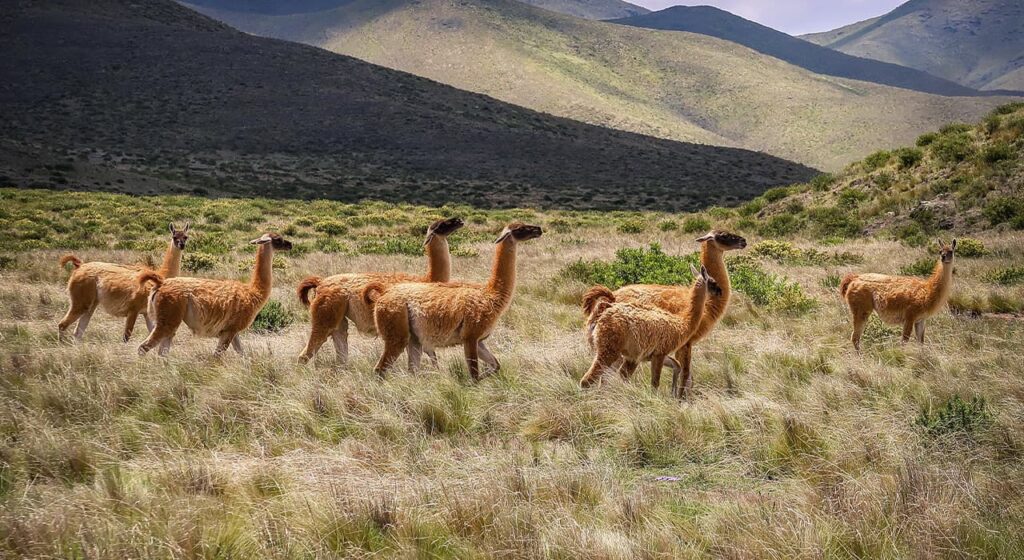This humpless camel is the result of breeding to produce a domesticated species with abundant, high-quality wool. Vicugna pacos (alpaca) is classified as a cloven-hoofed mammal, descended from Vicugna vicugna (vicuña or vigone). The vicugna itself belongs to the suborder Cerebaceous of the family Camelidae (camelids) .
Animals are attributed to the calloused animals because of the callus outgrowth that replaces the foot and hoof. Their two-toed limbs are equipped with blunt, curved claws that force the alpaca to walk by leaning on the phalanges of the toes. Due to this feature, all callosceles do not trample on pasture like sheep or goats. The alpaca has a split lower lip, no teeth on the upper jaw and strong incisors (growing for life) on the lower jaw. Due to the lack of upper teeth, animals pluck vegetation with their lips and chew with their side teeth.
Differences between the alpaca and the llama
Both belong to the camel family, but the alpaca is considered a direct descendant of the Vicuña species, while the llama is a descendant of the Guanaco species. The alpaca, which grows to about a meter tall, is usually slightly larger than a sheep, but almost half the size of a llama. An adult alpaca weighs 45-80 kilograms, and an adult llama weighs between 90 and 160 kilograms. They also differ in the configuration of their faces: llamas have more elongated faces, while alpacas have flat faces. On llama’s muzzle and head there is almost no hair, while alpaca has long shaggy bangs that cover its eyes. In addition, the llama has curved, banana-like ears on its head. Alpacas have smaller, triangular-shaped ears.
On the inside, the llama’s coarse coat is lined with undercoat, which is absent in the softer alpaca coat. In addition, the structure of its wool is denser, which allows you to cut many times more with less processing area. The difference is also observed in the characters. Friendly alpacas are not prone to kicking, biting and spitting for no reason, as do llamas. The latter sometimes distance themselves from the collective, while alpacas prefer to stay in the herd.
One last thing. Alpacas are cherished as the main producers of unique wool, so they are not used as pack animals (unlike llamas). It is said that llamas are even assigned herding functions to look after alpacas.
Wool
The alpaca has a soft long fleece that hangs 15-20 cm on the sides, which goes for felt, cloth or yarn. It is shorn in the same way as a sheep, but the wool is three times firmer and seven times warmer than that of a sheep. The color palette includes more than 52 (!) natural shades, the most popular (but not rare) among which is recognized white, as it is easier to dye.
Albino fleece is in high demand and sells more expensive, making white alpacas more profitable in breeding. Wool cut from young animals is especially valued in spite of its comparatively small volume (up to 1 kg in 2 years). For reference, an adult alpaca yields approximately 5 kg.
Properties of alpaca wool:
Does not contain lanolin (fat present in sheep’s wool);
hypoallergenic (it does not harbor dust mites);
The hair is soft and does not prick like sheep’s wool;
resistant to external pollution;
extremely lightweight;
well repels moisture.
All these qualities combine to make alpaca wool a valuable product, whose derivatives are characterized by practicality, brightness, purity, comfort and durability.
No wonder that people are increasingly buying products, not paying attention to their costliness.
The main advantage of alpaca, it is worth noting – the long fleece
Character and lifestyle
It seems to tourists that the animals lead a completely free way of life, but this is not true. Some alpacas are kept on special farms, while others (occasionally caught for shearing) have adapted to a semi-wild existence and free highland grazing.
Life in the wild
Alpacas are grouped in small herds, usually consisting of a single male and 4 to 10 females. There is a rigid hierarchy in the family with an aversion to extraneous males and an internal struggle for ranks. Animals are awake during the day and have a rest at night, during which time they intensively digest the food eaten during the day.
The herd members are quite lenient towards each other and get angry very rarely. From danger, as a rule, they run away. Despite their adaptation to the mountains, alpacas (unlike mountain goats) can only graze on horizontal areas with large areas. Survival in the harsh conditions of the high mountains (with a temperature differential of 30 degrees) is ensured by the remarkable characteristics of the fur, as well as the structure of the red blood cells.
Alpaca and humans
In captivity, alpacas quickly become accustomed to humans, demonstrating their best features – curiosity, peacefulness, shyness and charm. By their disposition, they are more reminiscent of cats, since they approach humans based on their own desire. Like all camels, alpacas occasionally spit, but they do it much less often than llamas, and usually out of necessity, to get rid of unpleasant stomach acid.
